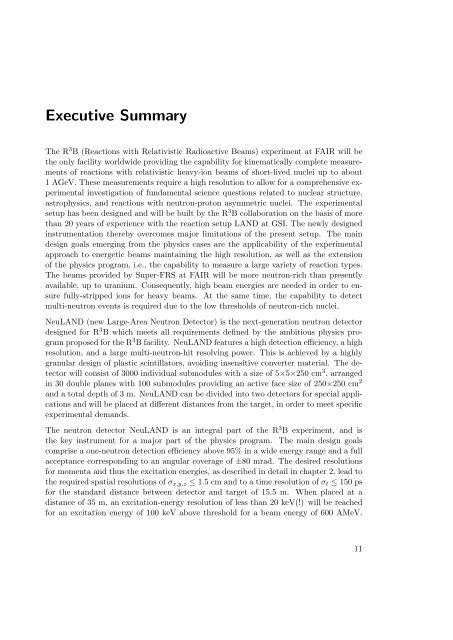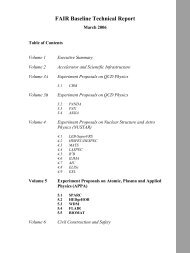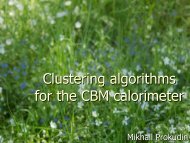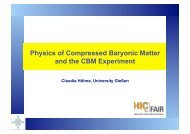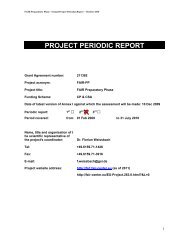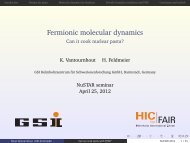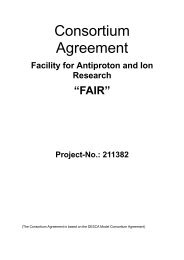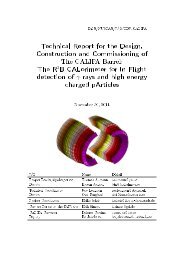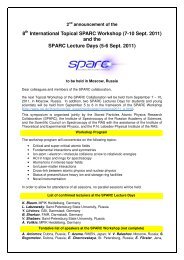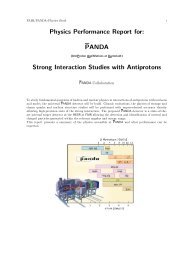NeuLAND - FAIR
NeuLAND - FAIR
NeuLAND - FAIR
You also want an ePaper? Increase the reach of your titles
YUMPU automatically turns print PDFs into web optimized ePapers that Google loves.
Executive Summary<br />
The R 3 B (Reactions with Relativistic Radioactive Beams) experiment at <strong>FAIR</strong> will be<br />
the only facility worldwide providing the capability for kinematically complete measurements<br />
of reactions with relativistic heavy-ion beams of short-lived nuclei up to about<br />
1 AGeV. These measurements require a high resolution to allow for a comprehensive experimental<br />
investigation of fundamental science questions related to nuclear structure,<br />
astrophysics, and reactions with neutron-proton asymmetric nuclei. The experimental<br />
setup has been designed and will be built by the R 3 B collaboration on the basis of more<br />
than 20 years of experience with the reaction setup LAND at GSI. The newly designed<br />
instrumentation thereby overcomes major limitations of the present setup. The main<br />
design goals emerging from the physics cases are the applicability of the experimental<br />
approach to energetic beams maintaining the high resolution, as well as the extension<br />
of the physics program, i.e., the capability to measure a large variety of reaction types.<br />
The beams provided by Super-FRS at <strong>FAIR</strong> will be more neutron-rich than presently<br />
available, up to uranium. Consequently, high beam energies are needed in order to ensure<br />
fully-stripped ions for heavy beams. At the same time, the capability to detect<br />
multi-neutron events is required due to the low thresholds of neutron-rich nuclei.<br />
<strong>NeuLAND</strong> (new Large-Area Neutron Detector) is the next-generation neutron detector<br />
designed for R 3 B which meets all requirements defined by the ambitious physics program<br />
proposed for the R 3 B facility. <strong>NeuLAND</strong> features a high detection efficiency, a high<br />
resolution, and a large multi-neutron-hit resolving power. This is achieved by a highly<br />
granular design of plastic scintillators, avoiding insensitive converter material. The detector<br />
will consist of 3000 individual submodules with a size of 5×5×250 cm 3 , arranged<br />
in 30 double planes with 100 submodules providing an active face size of 250×250 cm 2<br />
and a total depth of 3 m. <strong>NeuLAND</strong> can be divided into two detectors for special applications<br />
and will be placed at different distances from the target, in order to meet specific<br />
experimental demands.<br />
The neutron detector <strong>NeuLAND</strong> is an integral part of the R 3 B experiment, and is<br />
the key instrument for a major part of the physics program. The main design goals<br />
comprise a one-neutron detection efficiency above 95% in a wide energy range and a full<br />
acceptance corresponding to an angular coverage of ±80 mrad. The desired resolutions<br />
for momenta and thus the excitation energies, as described in detail in chapter 2, lead to<br />
the required spatial resolutions of σx,y,z ≤ 1.5 cm and to a time resolution of σt ≤ 150 ps<br />
for the standard distance between detector and target of 15.5 m. When placed at a<br />
distance of 35 m, an excitation-energy resolution of less than 20 keV(!) will be reached<br />
for an excitation energy of 100 keV above threshold for a beam energy of 600 AMeV.<br />
11


